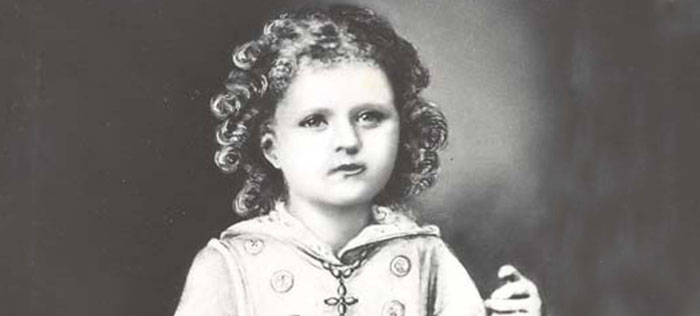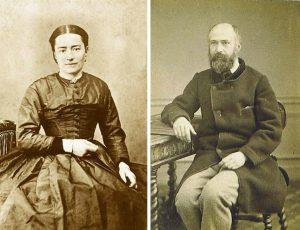 Saint Therese of Lisieux is one of the most beloved of God’s closest friends. Affectionately known as the Little Flower, her holiness of life attained global renown very quickly in the aftermath of her untimely death in 1897. For one who lived only 24 years, the final nine as a cloistered Carmelite nun, her speedy impact on the world was nothing short of phenomenal.
Saint Therese of Lisieux is one of the most beloved of God’s closest friends. Affectionately known as the Little Flower, her holiness of life attained global renown very quickly in the aftermath of her untimely death in 1897. For one who lived only 24 years, the final nine as a cloistered Carmelite nun, her speedy impact on the world was nothing short of phenomenal.A flower of such sanctity could only have bloomed in the holiest soil, but as we shall see, not without its challenges. Therese was the youngest of nine children born to Louis and Zélie Martin, successful middle class business owners. Five children, all daughters, survived to adulthood.
The Martin household was well known for selfless works of charity and steadfastness in their Catholic faith. Theirs was hardly a “Sundays only” faith. Rather, it permeated every aspect of their lives, as individuals and as a family. Louis and Zélie saw to it that their girls were brought up recognizing God as their loving Father, actively guiding them and working in their daily lives.
The girls’ love for God and desire to please Him ideally would have underscored all their interactions as a family. Human nature being what it is, however, this wasn’t always the case. Even the holiest of households experience challenges when different personalities and life experiences come into play.
Thérèse’s playful, precocious nature and admitted self-absorption in early childhood gave way to periods of acute depression and illness after Zélie’s death. Only four years old at the time, Therese became greatly attached to her older sister Pauline, her surrogate mother and “the major formative influence in her life,” according to Joseph F. Schmidt, FSC. His book, Everything is Grace: The Life and Way of Therese of Lisieux, chronicles the saint’s life and the evolution of her famous spirituality termed “the Little Way.”
While much loved within her family circle, Thérèse was no stranger to suffering in her early years. As it happened, another of the Martin daughters was faced with youthful challenges of her own, although very different from those of Thérèse.
Léonie Martin was the third of the five surviving daughters. In many ways, her story portrays a classic case of “middle child syndrome,” to use modern terminology. Situated between Marie and Pauline, the two highly responsible eldest; and Céline and Thérèse, the bright, lovable youngest, Léonie appears to have had a difficult time determining her rightful place.
In fact, Joseph Schmidt describes Léonie as “the ‘black sheep’ among the [Martin] children. Relatively unsociable, slow at studies, and sometimes obstinate and lacking in good judgment, she was considered a problem by her parents.” Other sources attest to her feelings of isolation within her family, expulsions from school, and troubled teen years.
Susceptible to illness from infancy onward, Léonie also endured physical and verbal abuse from a maidservant working in the Martin home. Like many children in similar tragic situations, then and now, Léonie suffered these abuses in silence until the situation was discovered not long before the death of her mother.
Léonie’s parents must have suffered greatly at their daughter’s struggles over the years. Louis —gentle, loving, seeing the good in everyone —called her his “good-hearted Léonie.” Her mother Zélie, even as her death from breast cancer neared, wrote touchingly of her efforts to reach Léonie, to achieve a firm, loving mother-to-daughter connection here on earth while there was still time.
As a young adult, Léonie continued to display impulsivity in decision-making and other signs of poor judgment. These became apparent even where her discernment of a religious vocation was concerned. All four of her sisters entered the convent of Carmel at Lisieux. Not surprisingly, Léonie chose a different setting. However, it wasn’t until her fourth attempt at life behind convent walls that she finally settled at the Visitation Monastery at Caen, taking the name Sister Francoise-Thérèse; she was then 35 years old. Clearly, her path into a religious vocation, as through her life to that point, was not an easy one.
Her troubled childhood and youth finally behind her, her Sisters in religion found Léonie to be kind and loving. Where Thérèse was concerned, Léonie, according to Joseph Schmidt, “came to imbibe and value her younger sister’s spirituality to a significant degree … She became one of Thérèse’s first and most faithful disciples outside of Carmel, living a saintly life in the spirit of the Little Way and dying a holy death in 1941.”
Just how saintly was Léonie’s life in the Little Way; just how holy her death? In answer, we find that on July 2, 2015, her cause for beatification and canonization was opened, giving her the title Servant of God.
Later that same year, both of Léonie’s parents joined her sister Thérèse in the canonized Communion of Saints. Surely, Louis’ and Zélie’s struggles with this most challenging of their children can be a source of comfort and intercession for today’s parents facing similar family situations. As for Léonie, she is the ideal patroness for those who have endured traumas and difficulties early in life, perhaps still suffering the effects many years later.
So as we commemorate the feast day of Saint Thérèse of Lisieux, we remember also these holy members of her birth family who attained the heights of the altar — her parents, Louis and Zélie— and the one whose official path toward those heights has begun only recently — her sister Léonie.
© All Rights Reserved, Living His Life Abundantly®/Women of Grace® http://www.womenofgrace.com


